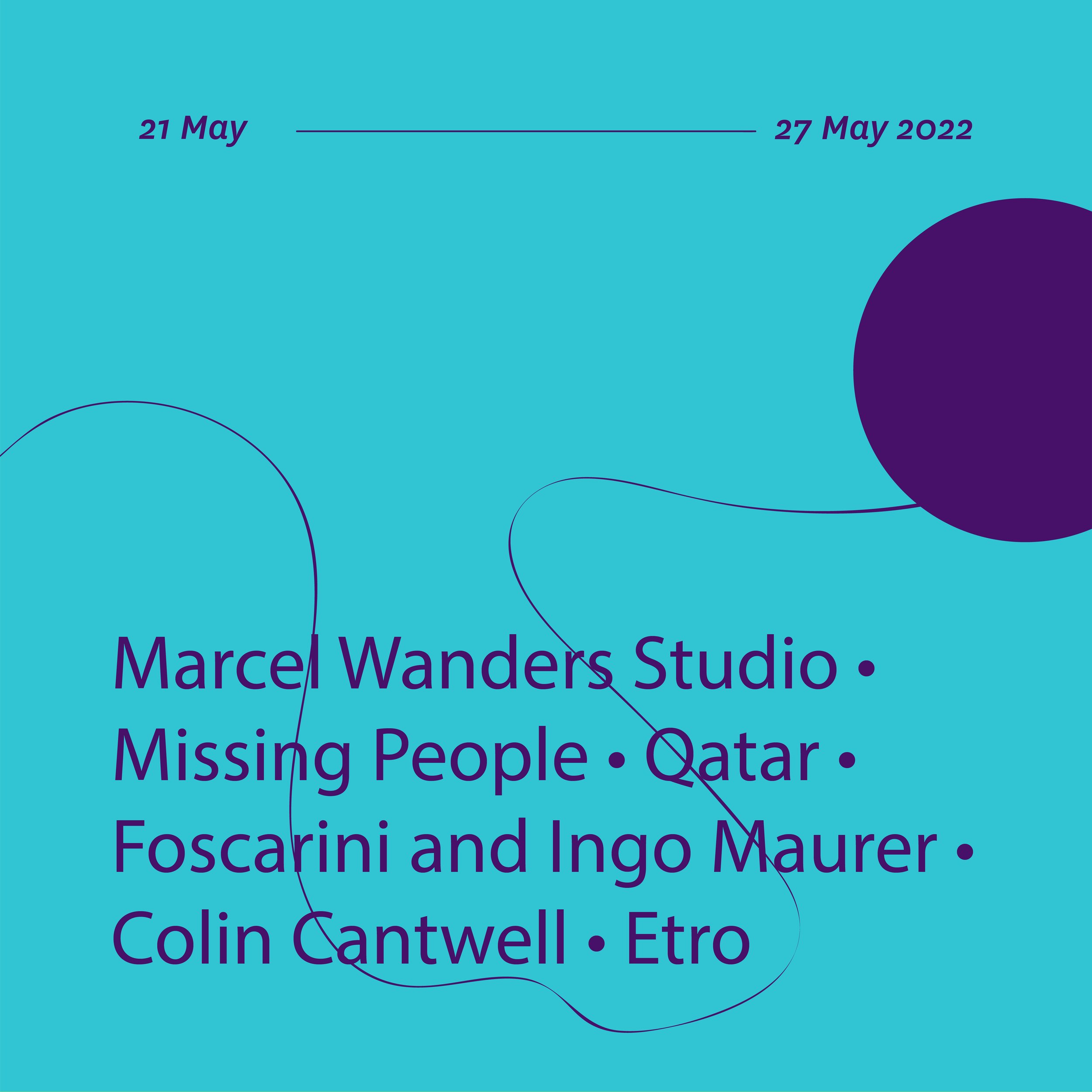The Design Line: 21 - 27 May
Sit tight! It’s this week’s Design Line, filled with news about the end of Marcel Wanders Studio; Amnesty International’s stand against the Qatar World Cup; a redesigned missing person poster; Foscarini’s acquisition of Ingo Maurer’s lighting company; Marco De Vincenzo’s move to Etro; and the death of Colin Cantwell, the designer behind Star Wars’s spaceships.
Marcel Wanders (left) and Gabriele Chiave, co-creative directors of the soon to be disbanded Marcel Wanders Studio (image: Marcel Wanders Studio).
A partial farewell to Marcel
Twenty years on from its establishment, Marcel Wanders Studio is to cease operations, with its eponymous founder citing a desire to focus on fewer projects in response to “an urgency inside myself to change something in my creative life and process”. As reported by Dezeen, Wanders’s decision was catalysed by a serious car accident that he suffered at the end of 2021 (and which, thankfully, he is recovering from). While Moooi, the design brand that Wanders owns, will remain unaffected by the decision, a support plan will be introduced within his Amsterdam studio to help employees “move on and to take the next step in their career.” While it is sad news for the studio’s team (to whom Disegno’s thoughts go out), it is a noteworthy development for Wanders, a designer whose latter career has been built around channeling his early experimental output into the development of his studio as a brand in itself. Marcel Wanders Studio has been famously prolific, creating more than 1,900 projects, and was commercially canny in its development of brand partnerships that played upon its founder’s celebrity. Now, however, Wanders has announced that he is “looking for focus, depth and meaning like never before in my life.” A new chapter? We wish him all the best.
Marco De Vincenzo, presumably gazing at Etro’s future (image: Etro).
Etro by De Vincenzo
When L Catterton, a private equity firm backed by LVMH, took a 60 per cent stake in Italian fashion company Etro in 2021, the maison promised that the €500m deal would allow the family-run company to “reach new heights.” This week, 10 months on from news of the deal breaking, Etro announced further details of how exactly L Catterton would be aiming to take the brand forward. Marco De Vincenzo – leather goods head designer at Fendi as well as the founder of his eponymous womens- and menswear label – is Etro’s new creative director, taking over from the former incumbents Veronica and Kean Etro. Announcing the news on Instagram, De Vincenzo thanked “all of you who are always by my side”, presumably reserving special thanks for LVMH, which is a backer of both L Catterton and De Vincenzo’s label, as well as owning Fendi. Giving De Vincenzo’s background, it would seem that he’ll be tasked with boosting Etro’s accessories offering, with his first collection due to debut at Milan Fashion Week in September.
Alexander Sloley has been missing from London since 2008 when he was 16 (image: Missing People).
The missing link
Missing posters’ raison d’être is to grab public attention and jog people’s memory. As such, their graphic design needs to be eye-catching, particularly given that the attention economy means that every available public surface is carpeted in posters vying for your eyeballs. As such, British charity Missing People has undertaken a radical redesign for its missing posters, with graphics underpinned by scientific research into the psychology of human behaviour. The word “MISSING” has been swapped with “HELP FIND”, moving away from something fear-based to a clear call to action instead. A scannable QR code – something the public has become intimately familiar with during the pandemic – removes the need for reams of descriptive text and allows passers-by to easily share the poster on social media. For digital billboards, the photograph of the missing person can even be manipulated so that it appears to move and blink. Moving portraits sounds like something out of Harry Potter, but if it helps find and help vulnerable people, then that’s a little bit magic.
An extremely questionable construction (image: Amnesty International).
A bloody game
The plight of construction workers in Qatar, and the responsibility borne by the architects who design the structures they risk their lives on, has been a hot button topic in the industry since the late Zaha Hadid stormed out of a BBC radio interview that raised the subject. With six months to go until the 2022 FIFA World Cup kicks off in Qatar, human rights charity Amnesty International is determined not to let the suffering of the workers who built the stadiums go unchallenged. In an open letter to FIFA president Gianni Infantino, Amnesty called for compensation for migrant workers employed on infrastructure projects ahead of the tournament. “The scale of human rights abuses linked to the World Cup is significant,” warned the charity, adding that deaths of migrant workers linked to heat and humidity could have been prevented with adequate health and safety. A Guardian report published last year estimated that at least 6,500 migrant workers have died in Qatar since it won the chance to host the World Cup back in 2010, although the official death toll for the event stands at only 37. While the stadiums are feats of architectural design, the ball games may as well be played on mass graves.
Flight of the Falcon
There are few designers who have shaped our collective imagination about space, fictional or otherwise, to a greater degree than Colin Cantwell. The Californian creator, who passed away this week at the age of 90, designed Star Wars space craft including the Death Star, the X-Wing, and the Millennium Falcon. Having trained at Frank Lloyd Wright’s School of Architecture, Cantwell began applying his Earthly design knowledge beyond the stratosphere when he worked on Stanley Kubrick’s 1968 film 2001: A Space Odyssey. He also worked for Nasa as part of the team that helped broadcast the 1969 moon landing. So it wasn’t his first galactic rodeo when George Lucas came calling in 1974 to ask him to work on his next project: Star Wars. As lead star ship designer, Cantwell drew inspiration for the stars from the most mundane of places. The X-Wing’s shape was inspired by observing darts in a British pub, while the plot-significant trench of the Death Star was a happy accident. When the two halves of the model for the space base shrunk, Cantwell was left with a gap that would have been laborious to sand and fill. “I went to George and suggested a trench,” Cantwell told the internet in his 2016 Reddit AMA. “He liked the idea so much that it became one of the most iconic moments in the film!” And while Cantwell may have sadly died, Star Wars and his work on it remains immortal; Obi Wan Kenobi’s spin off show began airing on Disney+ this week.
A very fine lighting designer indeed (image: Tom Vack).
Poetry for sale
Ingo Maurer (1932-2019) was one of the most influential lighting designers of the 20th and 21st century, exhibiting a whimsy, visual cheekiness and willingness to break with convention that continues to inspire designers today (his Ya Ya Ho project (1984) is cited by Stefan Diez as a major influence on his recent Plusminus (2022) system for Vibia). Maurer did not gain his nickname “the poet of light” for nothing, with works such as My New Flame (2012) with Mortiz Waldemeyer rendering candlelight in LED pixels, Lucellino (1992) recasting incandescent lightbulbs as winged Cupids, and Porca Miseria! (1999) redeploying smashed porcelain plates as a chandelier: “I’ve never seen anyone experiment with such abandon,” MoMA’s Paola Antonelli noted of Maurer’s work. This week, three years on from Maurer’s death, it was announced that his eponymous Munich-based brand would be entering a new chapter in its life, with Italian lighting company Foscarini acquiring 90 per cent of it (the remaining 10 per cent stays with Maurer’s daughter Sarah Utermöhlen). “Freedom, passion, charisma, and poetry,” Utermöhlen said of the deal, “the values of the Foscarini brand could not be a better fit for Ingo Maurer. We are convinced Foscarini is the right company to give further impetus and development to the artistic world of Ingo.”






